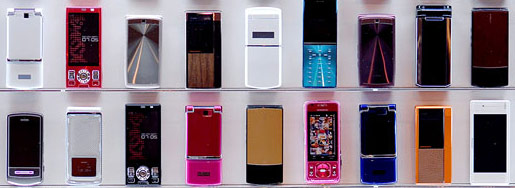Japanese Cellphones & Global Markets
 Lets take an A-B-C approach on this recent post from NYT. Since Gen Kanai has already provided a strong and balanced review, taking an open-source software approach, we will stick to the hardware aspect for our humble comments herein.
Lets take an A-B-C approach on this recent post from NYT. Since Gen Kanai has already provided a strong and balanced review, taking an open-source software approach, we will stick to the hardware aspect for our humble comments herein.
As long-time observers of the Japan market, with a decent grasp on the global stage considering that’s where many in our audience are based, we have a few thoughts about possible handset futures. As we see it, there are basically two niche ends of the spectrum: smartphones and emerging markets, so it’s reasonable to expect some near-term activity with DoCoMo and one or more of their handset partners getting underway in India, for example. A single digit share in either of those growth areas, let alone the main-stream replacement cycle, would easily surpass the home market annual volumes shipped as indicated at about 30M units. Now to the A-B-C heart of our argument.

A = Agreed with the NYT item in as much as the observation that the global share of Japanese branded handsets is well below what it should be, given the technical sophistication of their devices. And this is true for some of the reasons mentioned: many technologies are too advanced for emerging markets or even mature markets like the EU and US. However, the article pays no attention to the long-standing B2B business model between device makers and operators in Japan. Considering the advanced designs (and therefore price per unit), this ensures that a would-be buyer of a Japanese model overseas would facing a significant sticker shock, see this post on the Casio EXISLIM for Verizon as a recent example.
B = But, it’s certainly surprising the article made no mention of the obvious fact that ‘Nihon Inside’ runs a clear majority of the global handset base. From screen displays and cameras to chipsets and batteries the domestic hardware makers supply a wide range of critical components, and licensed IP, that enable mobile communications worldwide. As the saying goes, it’s what’s inside that counts!
C = Crisis?, of course it’s easy to play the numbers game to support any point of view. Yes, YoY handset sales are down, which, in Japan, is not exactly news. However, the Japanese vendors’ share of global sales on the basis of internal parts suppliers was not accounted for in the article. To be sure, we will see several brands step forward as platform standards become more aligned. Meanwhile, the domestic mobile content and services market – not counting advertising – grew by 17% in 2008, to 1.35 Trillion JPY (approx. $14 Billion USD) according to this news from the Ministry last Friday.
So, now what? A logical evolution for Japanese handset makers would be to offer slick handsets that target life after the on-board application era – when increasingly, like we’ve seen here for several years, contents and services will be running in the cloud. As major markets settle into mass 3G(+) adoption, with flat-rate data plans, it’s predictable that a default Flash install – a standard requirement here in Japan since 2004 – will enable a whole new rush of content and service plays not locked into a single portal offering. Considering the advancements in everything from flexible display technology, sensors, batteries and biometrics (to name a few), combined with a detailed focus on form and function – mastery the likes of Nintendo and Toyota have clearly demonstrated, it would seem reasonable to expect measured and continued international growth from the local handset makers.
To be fair, and call a spade a shovel (because, lets face it that’s why you love us!), the domestic makers did miss the first wave. The likes of Samsung and LG didn’t have much of a domestic market to lean on so they built for export, by design and cost per unit, from Day One. The Japanese were molly-coddled and nurtured by the operators, and largely shielded from any real competition. Is it too late in the game now for NEC, Panasonic, Sharp and Fujitsu (et al) to make a few good moves? Not by a long shot.
Maybe we’ll see them all pull together, each contributing their best of breed technology, under one umbrella and rolling out a new brand name – something like a LEXUS ‘Luxury Export for the United States’, for the global market. Now, wouldn’t that be interesting?

